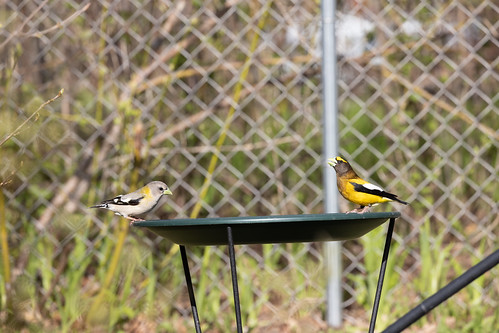Ever since early the morning of April 25, I’ve awakened every day to the lovely music of Evening Grosbeaks. Dozens, and sometimes well over a hundred, come to my yard for their all-stop shopping—my spruces, maples, and especially my three boxelder trees are major attractions, my two roofless platform feeders are kept full of sunflower seeds, I have several birdbaths, and my neighbors have a lovely backyard pond.
The birds start out the day here, but sometimes they head somewhere else at midmorning or midafternoon. They often come back, but sometimes I don’t see them again all day, so I keep thinking they’ll be moving on, but day after day, first thing in the morning here they are again.
It’s been thrilling having them here, bringing back the lovely days when my children were little right when my little grandson is just big enough to enjoy seeing them out the window. Back then, I vaguely remember the birds not going far when I went out to fill the feeders, returning the moment I walked away. Now that I’m specifically paying attention, I know they must be familiar with how feeding stations work because they return to the outside platform or the window feeder before I’ve hardly stepped away. Three pairs of starlings have been hanging out here, and when I see them at my window feeder, I wave my arms to chase them off. The grosbeaks sometimes leave with them, but usually at least one or two, and sometimes all of the grosbeaks, stay on the feeder. If they do leave, they come right back while the starling stays away for a good half hour.
My little dog Pip seems intrigued with all the bird activity. My office windowsill is just 18 inches above the floor, and a couple of times, Pip has stood up on her hind legs, paws on the sill, to watch the activity. The birds don’t seem to mind.
So much grosbeak activity is at least softening my disappointment at how slow migration is this year. I’ve seen single orioles and hummingbirds starting on Monday, and a Rose-breasted Grosbeak on Wednesday. I heard my first Rose-breasted Grosbeak song on the 13th, and starting on the 12th, a Baltimore Oriole has been singing away. A Brown Thrasher sang a few times from nearby from May 7 through 10, but that was it.
Meanwhile, the pair of chickadees nesting in our dead cherry tree have reached the incubating stage now. The female is so quick at darting in and out of the nest hole that the trail cam focused on it can’t get a picture in the split second between it detecting movement and the bird disappearing. I’ve gotten some good video by setting my camera on a tripod and leaving it to record for half-hour stretches. Out of a whole 40-gigabyte file, I end up with just a few seconds of action. Fortunately, the coming and going doesn’t vary from day to day—she’s on the eggs, then off for a bit to eat, get a drink of water, and preen and back again. I’ve also gotten a few cute videos and photos of her just peeking out the entrance.
The videos will get really interesting when the eggs hatch. I hope I can get video or photos of parents carrying eggshells away so I’ll know for sure when the babies hatch. At first the female will spend most of her time in the cavity keeping the brood warm while the male comes in with food and carries fecal sacs away, but as the chicks’ feathers grow in and they’re increasingly able to keep their own bodies warm, their hunger will also be growing, so soon both parents will be coming and going frequently.
I’m hardly going to be making any discoveries about chickadees, but it’s been fun noticing things like just how fast the female comes and goes, apparently to keep nest predators from discovering the nest. Already I’ve seen a crow and a Blue Jay sitting on the fence waiting to see the chickadee emerge or fly in. They couldn’t possibly get eggs or chicks inside the nest, but I’m sure both of them want to know when the babies fledge. Last year my Blue Jay family feasted on innocent baby House Wrens on their first day out. Much as I love Blue Jays, I’ll definitely be on high alert on chickadee fledge day.


